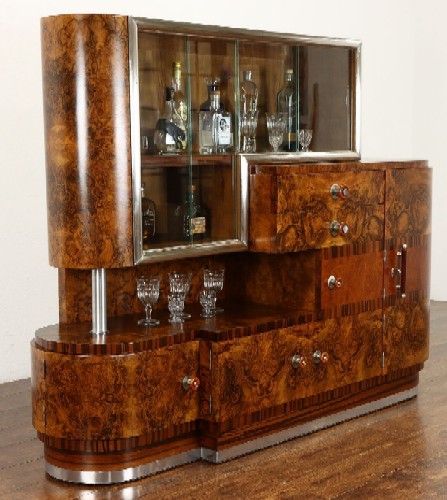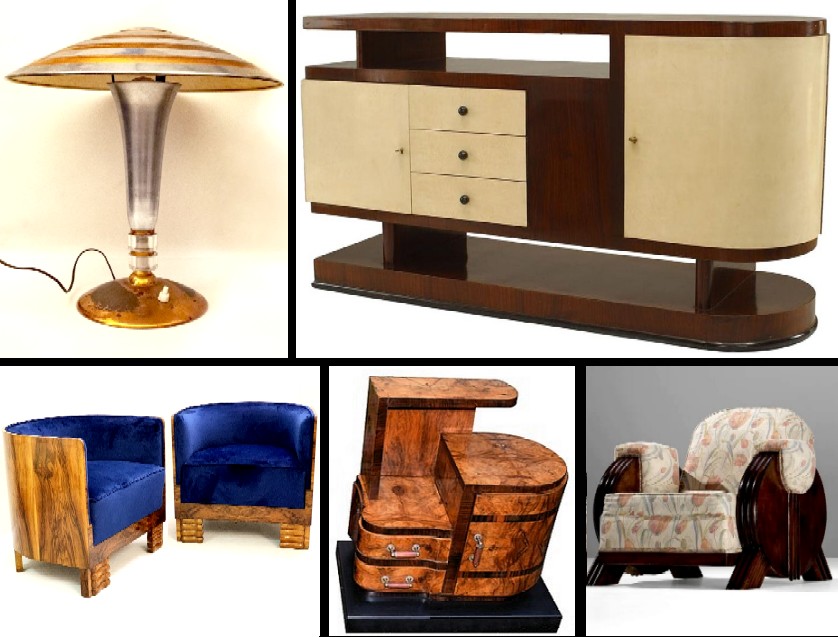
Italian Art Deco
Italian furniture from the Art Deco period is sometimes absolutely astounding in their intricacy. Although one of the stated aims of the Art Deco period was to simplify the complex forms which had preceded it,

Office and Library, Casa Savona, Palermo, Sicily, 1920, la Repubblica
the Italians married the simplified geometric forms with more complex ones, giving many of their Art Deco interior design pieces a very unique look, particularly before Italian Rationalism took over.
Industrial design came to the fore in Italy during the first world war. "The war period's emphasis on serial production and efficiency began to permeate the furniture industry, applying industrial design principles to furniture production." (Onur Tekin Uz, "The Rich Tapestry of Italian Furniture: From 19th Century Craftsmanship to Pre-War Innovation", Eruus Concept website, gathered 2/25/25) Active during this period were Italian furniture designers Giò Ponti, Mario Asnago, Claudio Vender, Franco Albini, Piero Bottoni, and Giuseppe Terragni who created handcrafted pieces which foreshadowed the industrial design which followed.
Italian furniture from this period is probably best described as 'fusion' furniture, a term which pops up repeatedly in descriptions of it, because it combined classical details with the geometric Art Deco style furniture which was making such a splash elsewhere in Europe. While similar to other Art Deco designs, the Italian design concept was slightly different. "Italian Art Deco interior design, despite its modernist leanings, also incorporated ornaments like elaborate patterns, ornamental light fixtures, and decorative sculptures." (Bardia Azizi, "Italian Art Deco Magic: Beauty of Italy's Design Era", Civilisable.com, gathered 3-19-24) The rich, traditional craftsmanship found in Italian Liberty (the Italian equivalent of Art Nouveau) was combined with designs which could be more easily produced. Italian Art Deco included "curved lines, geometric shapes,

Italian Cocktail Cabinet, Matched Olive and Ash Burl with Rosewood Band
Veneer,
Brushed Nickel and Bakelite Hardware, Plate Glass Doors, c. 1925, Harp Gallery
and luxuriant materials. In the beginning, the fusion of fine detailing with geometric and curved shapes, using luxurious materials such as velvet, leather, wood, and metal, was a symbol of Art Deco furniture. Bold colors like gold, silver, [and jewel color including] green, blue, and red, inspired by natural elements like flowers, leaves, and birds, added a unique feeling to the furniture of this era." (Civilisable)
Italian Art Deco furniture was presented at the "Triennale di Milano" where new ideas in furniture design were showcased. The event began with the 1st International Exhibition of Decorative Arts held in Monza, Italy in 1923. It was held every two years (a 'biennale') in Monza until 1927 during the early Art Deco period. It was changed to every three years (a 'triennale') beginning in 1930 taking place in the Palazzo dell'Arte di Musio in Milan with subsequent tri-annual events held in 1933 and '36 during the 'Streamline Moderne' period which was called Italian Rationalism. The exhibitions at the 1930 Triennale included the decorative art exhibition, the architecture exhibition and the modern home exhibition which contained 25 pavilions.
Italian Rationalism adopted the principles of the Modernist designers, making designs simpler, more functional and employing the sleek modern materials which were developed during the 20s and 30s. The roots of the style can be found in writings by members of Grupo 7, formed in 1926 by seven architects who called for the creation of a new architecture inspired by European Modernism. The style was advanced by designers like Marcello Nizzoli and Piero Fornasetti, exemplifying the Modernist mantra, 'Form follows function'. While resulting designs were aesthetically pleasing and utilitarian, the designs from this period are quite serious and restrained compared to the fantastic designs which preceded it.
Sources Not Mentioned Above:
"Milan Triennial", Italian Wikipedia, gathered 2-25-25
"Italian Rationalism: The Essence of Modernist Design", encyclopedia.design website, gathered 2-25-25 -
"Italian Rationalism", Imagicasa website, gathered 2-25-25
"Italian Rationalism", Domus, gathered 2-25-25
Original Facebook Group Post
 Italian Furniture, from left - Table Lamp, Chromed Metal, Copper and Glass, 1930s, Pamono; Sideboard, Walnut with parchment Veneer, Italian, 1930s, 1st Dibs; Arm Chairs Walnut with Blue Fabric, 1920s, Vintage; Nightstand, Italian Walnut, Rosewood and Macassar Ebony Veneer, Metal and Bakelie Hardware, Early 1930s, Antiques Atlas; Lounge Chair, Stained Beech Wood with Floral Pattern, Brass Highlights, 1940s, Morentz
Italian Furniture, from left - Table Lamp, Chromed Metal, Copper and Glass, 1930s, Pamono; Sideboard, Walnut with parchment Veneer, Italian, 1930s, 1st Dibs; Arm Chairs Walnut with Blue Fabric, 1920s, Vintage; Nightstand, Italian Walnut, Rosewood and Macassar Ebony Veneer, Metal and Bakelie Hardware, Early 1930s, Antiques Atlas; Lounge Chair, Stained Beech Wood with Floral Pattern, Brass Highlights, 1940s, Morentz